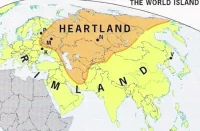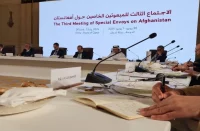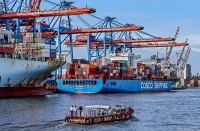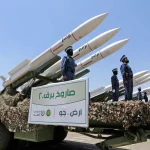Aleksandr Terentyev, Jr.
The large-scale operation by the Pakistani Army in South Waziristan and the proposed increase in size of the American military forces in Afghanistan are seen by many as a turning point in the fight against the Taliban, which will henceforth be forced to fight on two fronts. In the United States, what is happening in the Middle East has been called a triumph of the “AfPak” strategy announced by Barack Obama in March 2009.
HOWEVER, the optimistic picture painted by Washington strategists has nothing in common with reality. The Pakistanis are fighting their own, Pakistani, Taliban. They are paying the Afghan militants fighting NATO forces to stay neutral. Besides, the military elite of Pakistan have strong anti-American sentiments. As far as the U.S. military buildup is concerned, President Obama is becoming more and more inclined to the opinion of advisors who warn him against repeating the USSR’s negative experience.
CHAOSISTAN
For Obama’s doubts about whether or not to send additional troops to Afghanistan, the conservative columnist Charles Krauthammer called him a “young Hamlet” and advised him not to show the world that he is confused and has no clue about what to do next. Ike Skelton, who heads the House Armed Services Committee, has urged the President to follow the advice of the new Commander of U.S. forces Afghanistan, Stanley McChrystal, who argues that without fresh reinforcements the Americans risk being locked in “Chaosistan.” Another congressman, Jim McGovern, has drafted a bill for the phased withdrawal of American forces out of Afghanistan. Vice President Joe Biden has advocated scaling back the U.S. mission. According to a nationwide poll conducted by the Ipsos Social Research Institute, 56% of Americans oppose escalation of the conflict.
U.S. attempts to interfere in Afghanistan’s internal politics are looking more and more like a big farce. Washington had hoped that the presidential elections would allow Hamid Karzai’s regime to gain legitimacy. However, the extremely low turnout and disputed election results dashed those hopes. Rather than accept the inevitable, American diplomats for some reason began pressuring the Independent Election Commission, which finally recognized Karzai’s victory as invalid and initiated a second round of voting. According to observers, the Afghan leader was furious at this decision. A few days later, however, Karzai’s opponent—former Foreign Minister Abdullah Abdullah—refused to participate in the spectacle.
According to the former head of Saudi Arabia’s General Intelligence Department, Prince Turki al-Faisal, who played a key role in developing the West’s strategy in Afghanistan during the Soviet invasion, “The Americans should not spoil relations with Karzai by putting him in a negative light. This could only be done if a candidate able to compete with him is found.” But as the independent expert on Afghanistan Pyotr Goncharov said in an “Odnako” interview, “Karzai couldn’t lose the election.” As a representative of the Pashtun ethnic group, which dominates the government, he has managed to enlist the support of political heavyweights. He picked a Tajik as vice presidential candidate—Marshal Fahim, who has the backing of the officers of the Northern Alliance, which now forms the backbone of the Afghan Army. Mohammad Karim Khalili gave him the Hazari vote, and General Rashid Dostum, the Uzbeks.
Nonetheless, Taliban militants contemptuously call President Karzai the “mayor of Kabul,” implying he only controls the capital. According to experts, support by the ethnic leaders can only be explained by the fact that they are counting on Karzai to be weak, expecting him to wink how at commanders of armed formations are strengthening their positions in the regions. It is possible that over time the Afghan President will introduce reforms proposed by his rival Abdullah and agree to elections of provincial governors and an expansion of the powers of local authorities.
Some political analysts believe that decentralization will split Afghanistan into a Pashtun south, which will by controlled by the Taliban, and a Tajik-Uzbek north, which will be under the authority of the Northern Alliance.
A COLONIAL ACT
After the Obama administration became entangled in Afghanistan’s problems, it hoped to achieve success in Pakistan. The President signed the Kerry-Lugar bill to allocate $7.5 billion in aid to Islamabad However, the conditions imposed by American congressmen were totally unacceptable to the Pakistani military elite, which is not going to refrain from involvement in politics, scale down its nuclear program (many in Washington fear that the money will be spent on developing it) or give the United States access to Pakistan’s border areas. Fierce criticism was sparked by the provision of the bill that would give Washington the right to oversee Pakistan’s government structures, including the military, to ensure their actions are in the interest of the United States.
At a meeting of Pakistani Army unit commanders the Kerry-Lugar bill was called a “colonial act” that threatens the country’s national security. They did not care for the dictatorial and even offensive tone of the American lawmakers, which accused security officials of interfering in the affairs of the civilian government of Yousuf Gilani and of sheltering criminals who have carried out or planned terrorist acts in India.
Pakistan’s army chief, Ashfaq Kayany, and the chief minister of Punjab Province, Shabazz Shariff, whose brother is Nawaz Shariff, leader of the opposition Muslim League, decided to conduct a media campaign against “U.S. attempts to impose its own rules on Pakistanis.” Leading Pakistani newspapers have pronounced the president and his ministers as traitors who have sold out to the Americans. “Who but our accommodating government,” asked the Pakistani newspaper The Nation, “would agree to sacrifice our national interests for the sake of $7 billion? The U.S. approach to Pakistan is very well illustrated by the photograph of Richard Holbrooke taken during the negotiations: Obama’s special representative is shown sprawled in his chair, casually chewing gum. These new colonists got everything from Islamabad that they could possibly dream of.” According to opinion polls, about 85% of Pakistanis disapprove of cooperation with the United States.
OPPOSITION BY THE GENERALS
The Economist wrote that Pakistani generals believe the United States is imposing cooperation on their government under unfavorable terms, which once again proves that foreign policy must not be relegated to civilian authorities. Critics say the civilian government that came to power thanks to the support of the United States, which had lost confidence in General Musharraf, consistently champions the interests of its American patrons. Members of the opposition point out that President Asif Zardari lived for a long time in exile in the United States, and Prime Minister Gilani comes from a family with rich colonial traditions (his grandfather belonged to the elite in British India).
However, the government’s pro-American course runs counter to the nationalist ideology prevalent in the Pakistani establishment and security services. The civilian authorities’ control over Pakistan’s Inter-Services Intelligence (ISI) has weakened. This institution now is actually under the command of Ashfaq Kayani, and he is suspected of having links to retired nationalist generals who were forced out of their jobs in the security services during purges carried out by Pervez Musharraf in 2001. At that time, people were sent into retirement who had ties to jihadist organizations that had conducted combat operations in Afghanistan against Soviet forces, and who subsequently fought the Indians in Kashmir. Experts believe that these people continue to influence the thinking of security officials who do not wish to establish relations with America’s allies—India and Afghanistan—and who insist that Islamabad should turn the focus of its policy towards China.
THE CREATORS OF THE TALIBAN AND THE PASHTUN FACTOR
Up to a certain point in time, anti-American security officials were convinced that operations against the Pakistani Taliban based in the Mehsud tribal region in Waziristan was counter to the country’s interests. It was felt that ISI could control the radical Islamists by exploiting their militancy against “foreign occupiers and their puppet Afghan government.” During the Musharraf era only limited military operations were conducted in the so-called tribal areas on the border with Afghanistan, and the army’s large-scale offensive in February 2008 was unexpectedly terminated without explanation. Selig Harrison, director of the Asia Program at the Center for International Studies, wrote in his paper “Pakistan’s Internal and Foreign Policy after September 11” that in fact representatives of the Mehsud tribe then held high positions in the army and in intelligence, and General Musharraf did not want to make an enemy of the Taliban. Furthermore, Harrison adds, he was not interested in seeing the power vacuum that formed in Afghanistan after the fall of the Islamic government filled by representatives of the Northern Alliance, which has traditionally opposed an alliance with Pakistan. Musharraf was convinced that that he could negotiate with the Taliban and repeatedly concluded peace agreements with the leaders of the tribes inhabiting Waziristan.
In his autobiography “In the Line of Fire,” he noted that the Taliban were created by the Pakistani intelligence services, which educated, clothed and shod poor Pashtuns, gave them weapons and indoctrinated them in Islamic ideology. With the help of the Islamists, Pakistan’s elite hoped to establish in Afghanistan a friendly regime dependent on Islamabad and thereby secure their rear in the confrontation with India. During the 1990s, the Afghan Islamists financed by ISI even promoted the idea of a confederation of Pakistan and Afghanistan. ISI director Hamid Gul maintained that “under the pretext of unifying the two Islamic states we would get access to uranium mines in Afghanistan and reduce the dependence of Pakistan’s nuclear program on foreign sources. In addition, a political alliance between Islamabad and Kabul would be a serious challenge for India.
However, the Pakistani intelligence services were unable to realize their dreams. This was primarily due to the fact that no Afghan government would enter into rapprochement with Pakistan until the border dispute was resolved. The Durand Line, which was established by the British in 1893, divided the Pashtun tribal territories between Afghanistan and British India. This was contrary to Afghan interests, and Kabul refused to recognize the border drawn by colonial officials. After the Pakistani state was established, its relations with neighboring Afghanistan have always largely hinged on the Pashtun factor. The Afghans at one time even advocated the creation of an independent Pashtunistan in Pakistan’s Federally Administered Tribal Areas.
“By playing the Pashtun card,” says Pyotr Goncharov, “the Pakistani intelligence services created an Islamic movement in the tribal areas that was directed against the secular government in Kabul, but it became obvious over time that the Islamists will try to form an emirate over all Pashtun territory, which encompasses a large part of Pakistan.” When in 2008 the military leaders supported by the Islamists were replaced in Islamabad by a civilian government, the Taliban militants were fiercely opposed to its secular ideology.
THE PATH OF LIBERATION
Initially, they tried to take advantage of the weakness of the new authorities, and in February 2009 they concluded a peace agreement with them. The Gilani government announced that it would not prevent the introduction of Sharia law in the Swat Valley, and the Taliban for its part promised to cease military actions and not try to expand their influence to other areas of Pakistan. Soon, however, the militants violated the agreement, began an expansion in the tribal areas and pushed into territories located just a hundred kilometers from the capital. During the summer, government forces drove them out of the Swat Valley, and a decision was reached in September to undertake a large-scale offensive in South Waziristan.
The Taliban hoped to intimidate the government and force it to abandon its plans by organizing a series of bombings in Pakistani cities. However, the authorities were determined, and in late October they began the largest operation of the last six years against the Taliban under the rubric “The Path of Liberation.” A 30-thousand-man army, supported by aviation, tanks and artillery pushed into South Waziristan. The government had previously concluded a nonaggression pact with the Afghan Taliban who had settled in North Waziristan and with Waziri tribal leaders, who are traditionally hostile to the Mehsud tribe. In addition, the authorities were able to break the stereotype existing in Pakistan public opinion that the war with the Taliban is an “American war,” and that by taking part in it government troops are supporting the army of occupation in its fight against “the righteous warriors of Islam.” Army chief Ashfak Kayani made it clear that the military operation is directed only against extremists by issuing an appeal to the “brave people of the Mehsud tribe.”
Even before Waziristan became a symbol of Taliban resistance, it was famous for the intractable temperament and warlike nature of the tribes inhabiting it. This area has been independent of both the British colonial administration and the Afghan government since 1893. The Waziri rebellion in 1919-1921 led to Great Britain’s defeat in the Third Afghan War. Many experts believe that the Pakistani army is doomed to get bogged down in Waziristan, despite its initial success in the campaign—especially since the subjugation of the Pashtun tribes is still not a national security priority for Islamabad. As noted by The Times, despite the fact that the Pakistanis have decided on a major military operation in the Federally Administered Tribal Areas, most of the army, including its elite units, is located on the eastern border with India. Pakistan’s establishment has never managed to get rid of its paranoid attitude toward New Delhi. This is why the military has refused to accept the Afghan government of Hamid Karzai as a natural ally in its fight against the Taliban: Indeed, the Afghan President allowed Indian investors into the country and gave India permission to open 26 consulates on the Pakistani border, which, according to ISI, are responsible for destabilizing the situation in the western province of Baluchistan.
According to experts, the differences between the military and civilian authorities in Pakistan concerning the country’s foreign policy may bring down the current government, which would be replaced by generals who are hostile to the alliance with America and supported by the Muslim League.
Source: “Odnako” Magazine (in Russian), No. 9, November 9, 2009.














You know, I have to tell you, I really enjoy this blog and the insight from everyone who participates. I find it to be refreshing and very informative. I wish there were more blogs like it. Anyway, I felt it was about time I posted, I
I wanted to thank you for this excellent read!! I definitely enjoyed every little bit of it. I have you bookmarked your site to check out the new stuff you post.